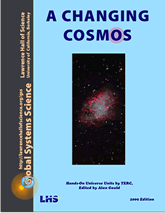AC9.3. Hubble’s Law
What’s the evidence that our Universe is expanding, contracting, or staying the same?
Materials
- Worksheet “Spectra of Fast-Moving Galaxies”
- Worksheet “Hubble’s Law”

The line spectrum of hydrogen, the most common element in the Universe, has characteristic lines (wavelengths or frequencies) in the regions red, turquoise, blue, and violet.
The boldest line in the hydrogen spectrum is in the red region. That is if the star or galaxy is not moving towards you or away from you. If it is moving towards you or away from you, each spectrum line will be shifted either toward the violet or toward the red end of the spectrum respectively because of the Doppler effect.
On the “Spectra of Fast-Moving Galaxies” sheet there are spectra of a number of galaxies. The darkest line indicated in each the spectrum is the one that is normally in the red region of the spectrum. With extreme Doppler shifts, that bold line can appear in radically different parts of the spectrum. The scales at the top and bottom of the sheet relate Doppler shifts of the galaxies’ spectra with velocities of the galaxies.
9.1. On the Spectra of Fast-Moving Galaxies sheet, which way are the spectra of most galaxies shifted, towards red or towards violet?
Positive velocity means the galaxy is moving away from us and negative velocity indicates the galaxy is moving towards us.
9.2. Are the galaxies moving towards us or away from us?
Find out how fast each galaxy is moving. Plot the speed on the “Hubble’s Law” worksheet to create a graph of distance vs velocity. Use a computer spreadsheet if you like.
9.3. What does the graph tell you?
The relationship between galaxy distance and velocity that you determined is called the Hubble Law because it was first discovered by astronomer Edwin Hubble.
9.4. What does Hubble’s Law imply about how our Universe is behaving?
Measuring red shift turns out to be yet another powerful way to estimate the distances to the most far away galaxies. The slope of the line on a graph of galaxy recession velocity vs distance is called the Hubble constant. Assuming Hubble’s Law applies for most galaxies, astronomers estimate distances to the most remote galaxies by measuring red shifts, finding velocities, and calculating distances from Hubble’s Law.
9.5. How distant is a galaxy that is found to be receding from us at 120,000 km/sec?
The data from which this “Spectra of Fast-Moving Galaxies” chart was constructed was fairly old—from the 1980s.
9.6. Find out what the currently accepted value of the Hubble constant is.
9.7 What is the relationship between Hubble’s Law and the age of the Universe?
9.8 How has human perception of the age of the universe changed throughout human history.
[Try search: “history of estimates of the age of the universe“]


